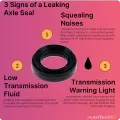
A taillight, also sometimes called a tail light or a rear light, is a light mounted on the rear of a car that illuminates when the headlights are turned on or when the brakes are applied. They serve two main purposes:
- To increase the visibility of the car to other drivers, especially in low-light conditions. This helps to prevent rear-end collisions.
- To signal to other drivers when the car is braking. This gives them time to react and slow down, further reducing the risk of accidents.
Taillights are typically red in color, as this color is more easily distinguishable from other light sources such as brake lights and turn signals. They may also incorporate white tail lights that illuminate when the car is in reverse.
In addition to the basic functions described above, some taillights also include additional features such as:
- LED technology: LEDs are more energy-efficient and durable than traditional incandescent bulbs.
- Reflective elements: These elements help to make the car even more visible to other drivers, especially at night.
- Automatic lighting: Some taillights automatically turn on when the car is put in reverse or when the headlights are turned on.
Is the taillight and brake light the same?
While they are often housed in the same assembly and look similar, taillights and brake lights are not the same. They serve different purposes and have different characteristics:
Taillights
- Always on: They illuminate whenever your headlights are on.
- Dim brightness: emit a steady, lower-intensity red light.
- Main function: Increase your car's visibility to other drivers, especially in low-light conditions.
Brake lights
- Activated by braking: They only light up when you press the brake pedal.
- Brighter than taillights: Shine significantly brighter than taillights, often with more intense red color.
- Main function: Alert other drivers that you are slowing down or stopping to prevent rear-end collisions.
Additional points
- Some vehicles use the same bulb for both functions, with different filaments activated depending on the situation.
- Newer cars might have separate light sources for taillights and brake lights.
- Both should be red in color (except for reverse lights, which are white).
- Both are crucial for safe driving and visibility on the road.
So, while they may appear similar, taillights and brake lights on many vehicles have distinct functions and play vital roles in road safety.
Is it OK to drive with a taillight out?
No, it is not okay to drive with a taillight out. Here's why:
Safety Risk
- Reduced visibility: A burned-out taillight significantly reduces your vehicle's visibility to other drivers, especially at night or in bad weather. This increases the risk of rear-end collisions, as drivers behind you may not have enough time to react to your braking or stopping.
- Missed brake signals: Without a functioning brake light, other drivers may not see when you're slowing down, leading to potentially dangerous situations.
Legality
- Traffic violation: In most jurisdictions, driving with a malfunctioning taillight is considered a traffic violation. You could be pulled over and issued a ticket, which may come with a fine and penalty points on your license.
- Vehicle inspection: If your car needs to pass a safety inspection, a non-functional taillight will likely cause it to fail. So, ensure you're up-to-date with preventative maintenance.
Therefore, it's crucial to address a burned-out taillight as soon as possible. Here are your options:
- Replace the bulb: This is usually a simple and affordable fix. Many auto parts stores and mechanics can help you find the right bulb for your car.
- Seek professional repair: If the issue is more complex or you're uncomfortable replacing the bulb yourself, take your car to a qualified mechanic for repair.
Remember, driving with a functioning taillight is not just about avoiding tickets but also about ensuring your own safety and the safety of others on the road. So, make sure you're up-to-date with preventative maintenance. Many vehicles like Hondas have specific maintenance and repair schedules and tips to help you care for them better.
Should my taillight always be on?
No, your taillight should not always be on. While it's true that some modern cars have daytime running lights (DRLs) that illuminate the front and sometimes the rear of the vehicle even during the day, these are not the same as taillights.
Why taillights shouldn't be on all the time:
- Unnecessary drain on battery: Keeping them constantly lit would reduce your car's battery life, potentially leading to issues starting the engine. This means the taillights will constantly pull a charge from the battery, which can cause the same result as a parasitic draw.

- Reduced effectiveness: If taillights are always on, they can become dimmer for electrical reasons, or simply wear out. This causes an impact in alerting other drivers during critical moments like braking might be diminished.
In summary:
- Use your headlights and taillights together when visibility is low.
- DRLs are a safety feature, but they don't replace the need for taillights.
- Always follow your local traffic regulations regarding lights.
Why does my brake light work but not my taillight?
There are several potential reasons why your brake light might be working while your taillight isn't. Here are the most common culprits:
Burned-out bulb
This is the most likely reason. Some vehicles have a single bulb with separate filaments for the taillight and brake light. If the taillight filament burns out, the brake light function might still work. Alternatively, your car might have separate bulbs for both tail lights and other functions, and only a taillight bulb is faulty.
Fuse issue
Your car's electrical system uses fuses to protect different circuits on brake and tail lights from overloading. If the fuse responsible for the taillight has blown, it will prevent the light from functioning while the brake light, powered by a different fuse, remains unaffected. Sometimes the fuse box can overheat and melt, causing fuse issues and a burning plastic smell.

Wiring problems
Damaged, loose, or corroded wiring connecting the taillight and tail light assembly, could be interrupting the power supply to the taillight specifically.
Light assembly issues
In rare cases, there might be internal problems with the taillight assembly itself, such as damaged contacts, broken lenses, or a faulty ground connection.
Switch problems
If your car has a separate switch for taillights and brake lights, a malfunctioning switch could be responsible for the taillight issue. When this type of issue happens with brake lights, the car might even struggle to shift out of "park," depending on its safety features.

Diagnosing the problem
To figure out the exact cause, you can:
Visually inspect the taillight bulb: Check if it looks burned out or damaged.
Consult your car's owner's manual: It should identify the fuse responsible for the taillight and guide you on replacing it.
Look for visible signs of damage: Check for loose or frayed wires around the taillight assembly.
Safety first
Remember, driving with a non-functioning taillight is unsafe and illegal in most places. If you're unsure about the cause or uncomfortable fixing it yourself, it's best to take your car to a qualified mechanic for diagnosis and repair. They have the tools and expertise to safely identify and fix the problem.
Some vehicle makes have great technologies focused on taillights. This is the case with Honda, which often receives top safety ratings, in part due to their well-designed taillights.
How long do car tail lights last?
The lifespan of a car taillight depends on several factors, including:
Bulb type
Incandescent bulbs: These traditional bulbs have a shorter lifespan, typically lasting 2-5 years.
LED bulbs: The most durable option, with lifespans exceeding 10-12 years and sometimes even longer. Many Hondas have LED bulbs, as the company was one of the first to introduce this technology.
Other factors
Driving habits: Frequent braking and use of brake lights and tail, can wear down bulbs faster.
Environmental factors: Exposure to extreme temperatures or harsh weather can shorten lifespan.
Quality of the bulb: Choosing a reputable brand and avoiding cheap replacements can make a difference.
New technologies: Be careful on some new vehicles as the ADAS camera may be built into the lens. This could require special service procedures when replacing bulbs.
Therefore, it's difficult to provide a single, definitive answer for how long taillights last. However, here's a general guideline:
- Incandescent: 2-5 years
- Halogen: 3-7 years
- LED: 10-12+ years (or even longer)
It's important to regularly check your rear lights and taillights for signs of wear and tear, such as:
- Dimness or flickering
- Burned-out filaments
- Moisture buildup inside the lens
- Cracks or damage to the lens
Other news
-
Car is Squealing When Driving
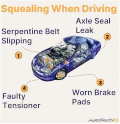
-
What is Preventative Maintenance and What Are The Benefits of it?

-
JobViewIQ - DVI Process Training - Part of the Auto Care Alliance Benefits

-
7 Signs of AC Pulley Issues
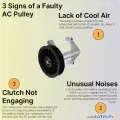
-
7 Signs of Clogged AC Components
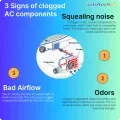
-
How Much Does a Transmission Fluid Change Cost?
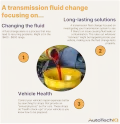
-
7 Signs of a Leaking Axle Seal
